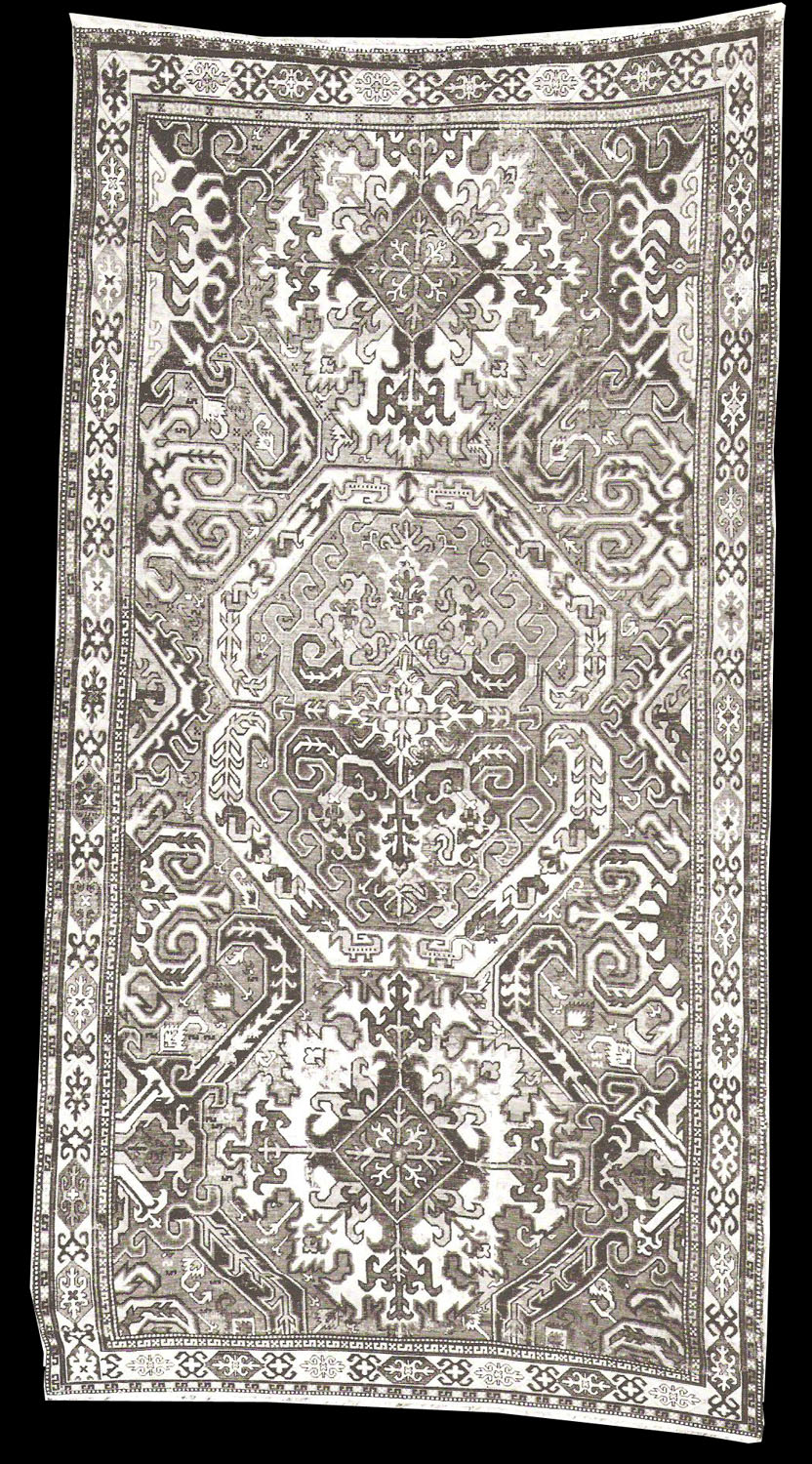|
Sunburst Carpet. Karabagh, Shusha Area. 18th Century. Museum of Fine Arts,
Boston 06.2527.
A typical example of a normal sunburst carpet with three dominant forms, in
which the sunburst may either be the central motif or the two outer ones: in
which it may be rayed, or assume this jagged, "cloud-collar" character. The
alternate motif, the irregular octagon, with its clasping lancet leaves,
remains much more constant in appearance. The ground of this rug is a rose
red. The "sunbursts" are ivory white; their central area violet, edged blue
and tan, with violet Finials. The centerpiece is half blue-green, half pale
green, with violet and yellow decor. The sweeping, clasping lancets are
ivory with little yellow animals and green and yellow "chi", or fungoid
forms. The tarantula-like palmettes in the corners of the field are blue,
with sweeping black-brown lancets. The figures that resemble octopi are
yellow. The yellow border is unusual; its checked outer guard stripe red,
the inner blue.
A very similar, but later appearing rug was in the Dr. Hugh Black 1927
auction in New York, No. 191, and more recently has been at C. John's in
London. Another rug of this kind, with reciprocal border, was in the Jacoby
"Sammlung" (1923: PI. 11); a short example, showing a scant half of each
sunburst, was in a Budapest collection. All have blue grounds. The companion
arrangement, in which the sunburst becomes the centerpiece, occurred in a
rug at Jekyll's in London, published by Kendrick in Burlington Magazine long
ago and a late carpet which was in the Castiglioni Collection in Vienna, as
well as No. 55 of the Museum of Turkish and Islamic Art in Istanbul, from
Sivas, a compromise, Tor one outer motif is incomplete.
The former was apparently on red, the latter pair on blue.
Rugs with this scheme, in which the sunburst centerpiece is rayed, have
passed through the hands of Barbieri in Genoa and Vigo in London, Bernheimer
in Munich. Half of one was auctioned by Berberyan in New York: Martin
illustrated another (Pl. XXIX) from an old collection in Sweden. Museum of
Turkish and Islamic Art No. 896,7,8 are three portions of another; No. 729
and 726 represent increasingly distorted versions. Michael Frames in London
has a miniature carpet which shows the tips of sunbursts beyond a single
octagon. Most of these rugs display the tiny "chi" forms on the big lancet
leaves—a discreet link persisting to the art of the Far East.
Analysis courtesy of Larry Salmon
Size: L. 4.35 m. (14'3") (excluding fringe) x W. 2.26 m (7'5").
Warp: Z2S wool in beige with some purplish brown. Alternate warps depressed.
Weft: Z2S ivool in beige with some purplish brown. TV-shots. Occasional
single shot, not a cable.
Pile: 2Z wool, Gordes knotted, pile slanting to left. 7 or 8 horiz. x 6 or 7
vert, per in. (about 49 per sq.in.)
Sides: Yellow wool selvage, 2 cords, selvage attached one or two warps into
pile.
Ends: Renewed.
Colors: ("ream; dark brown; tan; light and dark blues: red; purple;
blue-green; light and medium greens: yellow.
Condition: One end border rcwoven, small areas reknotted throughout.
Unpublished.
Charles Ellis,
Early Caucasian Rugs, Textile Museum, Washington D.C., 1975, plate 17
|
 |

